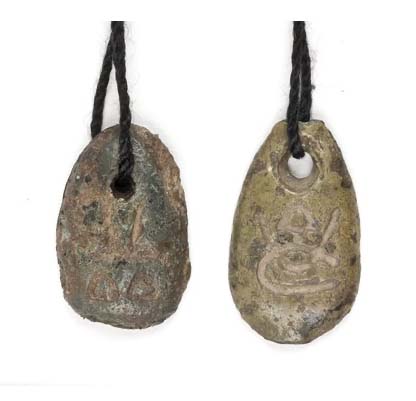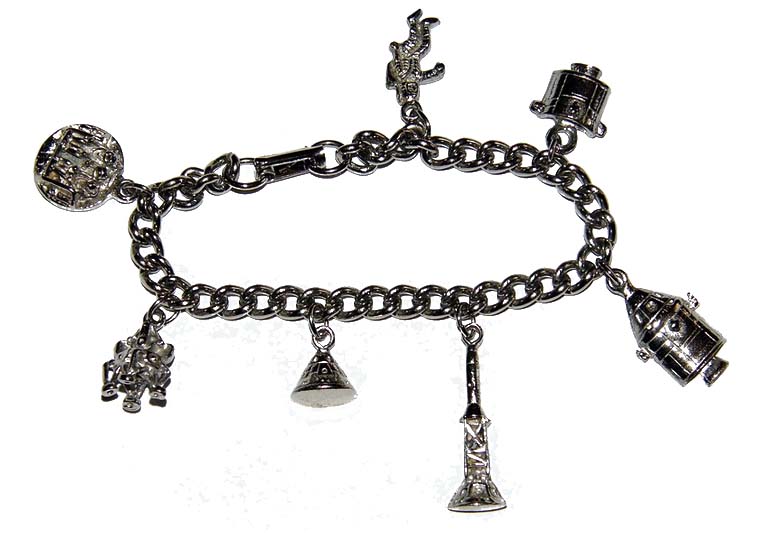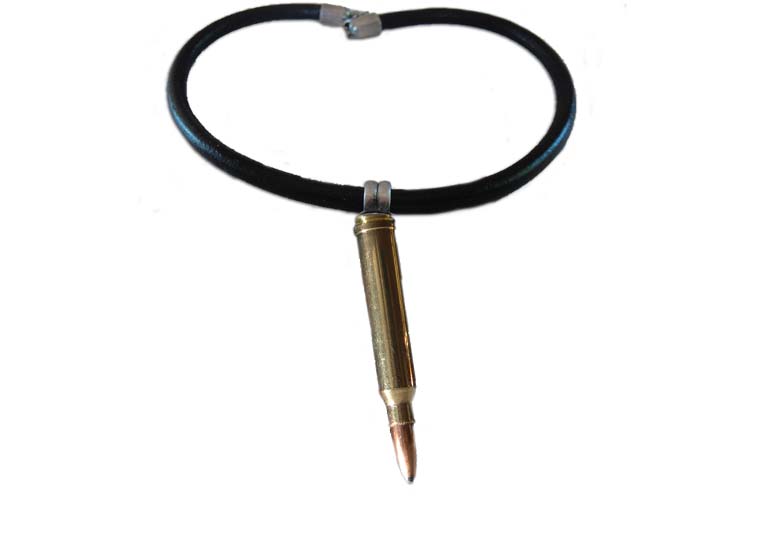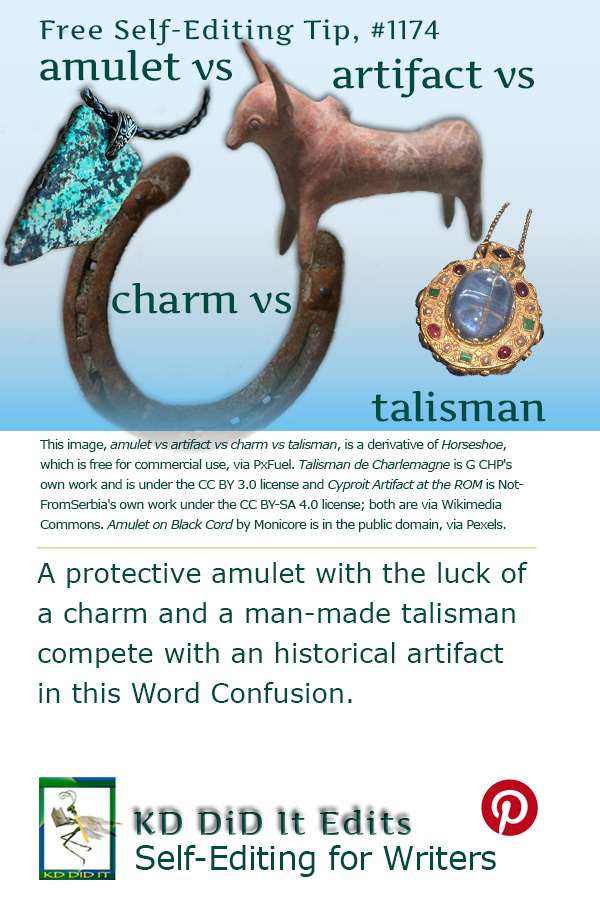I was re-reading Eileen Wilks’ Night Season, and the words artifact and talisman cropped up. I got to wondering if there was a difference, and then charm and amulet leapt into this word confusion.
Now, Webster states that “a charm [originally spoken or sung] is worn to attract good luck; an amulet provides protection from danger; and, a talisman is used to attract a particular benefit to its owner”.
An amulet is a natural object made wearable that is intended to provide protection through prevention or repelling.
An artifact is an object shaped by human workmanship, mostly one of historical or archaeological interest. It has come to include computer software development and enterprise architecture.
A charm may provide delight, be appealing, or an object that brings good luck. Or it’s associated with physics. Which does not give me any delight *grin*!
A talisman can be a man-made object or a person who is thought to bring good luck.
Technically, amulet, charm, and talisman have their specifics, and I do like Webster’s distinctions. Yet most of the dictionaries indicated that all three were interchangeable. So, it’s up to you writers to choose what best suits your story . . . just be consistent in how you apply the word.
Exploring Later . . .
“Ancient vs Antiquate vs Antique vs Antiquity” may be of interest.
Word Confusions . . .
. . . started as my way of dealing with a professional frustration with properly spelled words that were out of context in manuscripts I was editing as well as books I was reviewing. It evolved into a sharing of information with y’all. I’m hoping you’ll share with us words that have been a bête noire for you from either end.
If you found this post on “Amulet vs Artifact vs Charm vs Talisman” interesting, consider subscribing to KD Did It, if you’d like to track this post for future updates.
| Amulet | Artifact | Charm | Talisman |
|---|---|---|---|
 |
 |
 |
 — |
| Part of Grammar: | |||
| Noun
Plural: amulets |
Noun
Plural: artifacts |
Noun
Plural: charms Charm is also an adjective and a verb, which won’t be addressed in this post. |
Noun
Plural: talismans |
An ornament or small piece of jewelry thought to give protection against evil, danger, unhappiness, or disease
|
An object made by a human being, typically an item of cultural or historical interest
Something observed in a scientific investigation or experiment that is not naturally present but occurs as a result of the preparative or investigative procedure [Computer software] Anything created so a piece of software can be developed |
The power or quality of giving delight or arousing admiration
A small ornament worn on a necklace or bracelet An object, act, or saying believed to have magic power
[Physics] A characteristic property of certain subatomic particles expressed as a quantum number |
An object, typically an inscribed ring or stone, that is thought to have magic powers and to bring good luck
Any amulet or charm Anything whose presence exercises a remarkable or powerful influence on human feelings or actions |
| Examples: | |||
| In other communities people carry amulets with them to protect themselves from the evil eye.
“He had a different amulet for each stage in his political career” (Rose). “He was buried on his back in a painted wooden coffin with a glazed amulet” (Neporent). |
The tomb was strewn with gold and silver artifacts.
Widespread tissue infection may be a technical artifact. There are a wide variety of artifacts in our world, ranging from cultural, historical, enterprise architecture, computers, symbolic, media, and more. A family artifact is typically a physical item that has special value to your family because it belonged to someone who is no longer living, was given to you by a parent or grandparent, or tells an important story about someone in your family” (Mercedes). Some artifacts of software development “might include things like data models, diagrams, setup scripts”, etc. (What). “Some artifacts explain how a piece of software is supposed to work, while others actually allow that program to run” (What). |
His charm has captivated the media.
We explored the hidden charms of the city. The trinkets were charms from his wife’s bracelet. The dreamcatcher is a charm used to prevent bad dreams. I can’t find my good luck charm. “The charm quark, charmed quark or c quark (from its symbol, c) is the third-most massive of all quarks, a type of elementary particle” (Charm). |
Those rings, so fresh and gleaming, were their talismans.
A dolphin talisman would ensure a safe journey on land or at sea. He’s a quiet man off the field, but on it he’s our talisman. |
| Derivatives: | |||
| Adjective: amuletic | Adjective: artefactual [British], artifactual | Adjective: charmed, charming, charmless Adverb: charmingly, charmlessly Exclamation: charmed Noun: charmer, charmlessness Verb, transitive: charmed, charming, charms |
Adjective: talismanic |
| History of the Word: | |||
| Late 16th century, from the Latin amuletum, is of unknown origin. | Mid-17th century from the Latin arte (by or using art) + factum (something made, a neuter past participle of facere meaning make). | Middle English in the senses incantation or magic spell and to use spells, is from the Old French charme (noun), charmer (verb), from the Latin carmen meaning song, verse, incantation. | Mid-17th century based on the Arabic ṭilsam, apparently from an alteration of the late Greek telesma meaning completion, religious rite, from telein meaning complete, perform a rite, which is from telos meaning result, end. |
C’mon, get it out of your system, bitch, whine, moan . . . which words are your pet peeves? Also, please note that I try to be as accurate as I can, but mistakes happen or I miss something. Email me if you find errors, so I can fix them . . . and we’ll all benefit!
Satisfy your curiosity about other Word Confusions on its homepage or more generally explore the index of self-editing posts. You may also want to explore Book Layout & Formatting Ideas, Formatting Tips, Grammar Explanations, Linguistics, Publishing Tips, the Properly Punctuated, Writing Ideas and Resources, and Working Your Website.
Resources for Amulet vs Artifact vs Charm vs Talisman
Some of these links may be affiliate links, and I will earn a small percentage, if you should buy it. It does not affect the price you pay.
Apple Dictionary.com
Cambridge Dictionary: amulet
“Charm Quark.” Wikipedia. 1 May 2023. Web. 6 May 2023. <https://en.wikipedia.org/wiki/Charm_quark>.
Dictionary.com: amulet vs talisman
Mercedes. “What is a Family Artifact?” Who are You Made Of.com. 4 Apr 2023. Web. 6 May 2023. <https://whoareyoumadeof.com/blog/what-is-a-family-artifact/>.
Neporent, Liz. “Oldest Evidence of Human Cancer Discovered in African Tomb.” ABC News. 18 Mar 2014. Web. 6 May 2023. <https://abcnews.go.com/blogs/health/2014/03/18/oldest-evidence-of-human-cancer-discovered-in-african-tomb/>.
Rose, Lisa. “Creepy New Jersey: The stuff of legends.” Entertainment. NJ.com. 13 Apr 2012. Web. 6 May 2023. <https://www.nj.com/entertainment/2012/04/creepy_new_jersey_the_stuff_of.html>.
Webster, Richard. “Amulets, Talismans, & Charms.” Crystals and Gems. Llewellyn.com. 19 Apr 2004. Web. 6 May 2023. <https://www.llewellyn.com/journal/article/583>.
“What is an Artifact? Everything You Need to Know.” Artifacts. 8 May 2020. Web. 6 May 2023. <https://artifacts.ai/what-is-an-artifact/>.
Pinterest Photo Credits:
Horseshoe is free for commercial use, via PxFuel.
Talisman de Charlemagne is G CHP‘s own work and is under the CC BY 3.0 license and Cyproit Artifact at the ROM is NotFromSerbia‘s own work under the CC BY-SA 4.0 license; both are via Wikimedia Commons. Amulet on Black Cord by Monicore is in the public domain, via Pexels.


